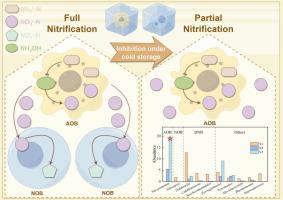Inhibition under cold storage can accelerate the realization of stable partial nitrification
IF 13.3
1区 工程技术
Q1 ENGINEERING, CHEMICAL
引用次数: 0
Abstract
Stable and efficient partial nitrification (PN) can provide the necessary substrate nitrite (NO2–-N) for anaerobic ammonia oxidation (ANAMMOX). However, the establishment of rapid and efficient PN is always challenging. In this study, we investigated the effects of inhibition under cold storage on the activity of ammonia-oxidizing bacteria (AOB) and nitrite-oxidizing bacteria (NOB) in activated sludge, as well as on the overall performance of the system during the establishment of PN. The control group R1 was set up using traditional control methods such as low dissolved oxygen (DO) concentration and intermittent aeration. In addition to the same control conditions as R1, R2 established PN more quickly after the inhibition under cold storage. R2 showed the effect of nitrous accumulation at day 25, whereas R1 showed nitrous accumulation until day 55. The nitrite accumulation rate (NAR) of R2 had reached 96.52% at day 77, whereas the NAR of R1 was higher than 90% until day 89. In addition, the gap between AOB and NOB activities was widened earlier within R2 compared to R1. High-throughput results showed that the abundance of AOB in inoculated sludge and final R1 and R2 was 0.03%, 5.50% and 19.01%, respectively, and the abundance of NOB was 1.84%, 0% and 0.05%, respectively. It can be seen that the strategy of inhibition under cold storage is helpful to accelerate the realization of PN and maintain a high abundance of AOB. This study provides a new strategy for the rapid establishment and stable operation of PN.

求助全文
约1分钟内获得全文
求助全文
来源期刊

Chemical Engineering Journal
工程技术-工程:化工
CiteScore
21.70
自引率
9.30%
发文量
6781
审稿时长
2.4 months
期刊介绍:
The Chemical Engineering Journal is an international research journal that invites contributions of original and novel fundamental research. It aims to provide an international platform for presenting original fundamental research, interpretative reviews, and discussions on new developments in chemical engineering. The journal welcomes papers that describe novel theory and its practical application, as well as those that demonstrate the transfer of techniques from other disciplines. It also welcomes reports on carefully conducted experimental work that is soundly interpreted. The main focus of the journal is on original and rigorous research results that have broad significance. The Catalysis section within the Chemical Engineering Journal focuses specifically on Experimental and Theoretical studies in the fields of heterogeneous catalysis, molecular catalysis, and biocatalysis. These studies have industrial impact on various sectors such as chemicals, energy, materials, foods, healthcare, and environmental protection.
 求助内容:
求助内容: 应助结果提醒方式:
应助结果提醒方式:


